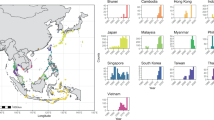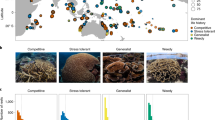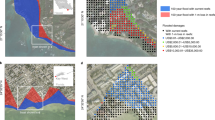Abstract
Coral reefs are popular for their vibrant biodiversity. By combining web-scraped Instagram data from tourists and high-resolution live coral cover maps in Hawaii, we find that, regionally, coral reefs both attract and suffer from coastal tourism. Higher live coral cover attracts reef visitors, but that visitation contributes to subsequent reef degradation. Such feedback loops threaten the highest quality reefs, highlighting both their economic value and the need for effective conservation management.
This is a preview of subscription content, access via your institution
Access options
Access Nature and 54 other Nature Portfolio journals
Get Nature+, our best-value online-access subscription
$29.99 / 30 days
cancel any time
Subscribe to this journal
Receive 12 digital issues and online access to articles
$119.00 per year
only $9.92 per issue
Buy this article
- Purchase on Springer Link
- Instant access to full article PDF
Prices may be subject to local taxes which are calculated during checkout


Similar content being viewed by others
Data availability
The live coral cover data are available in the Zenodo repository (https://doi.org/10.5281/zenodo.4292660). The human activity, site accessibility and water conditions data are available through the Ocean Tipping Points project (http://www.pacioos.hawaii.edu/projects/oceantippingpoints) and the Hawaii Statewide GIS Program (https://geoportal.hawaii.gov/search?collection=Dataset). Meta reached out to the authors after publication and asked that the original Instagram dataset uploaded in the accompanying Zenodo repository be removed from public access to limit user data exposure and its risk of misuse.
Code availability
Meta reached out to the authors after publication and asked that the original web-scraping script uploaded in the accompanying Zenodo repository be removed from public access to limit user data exposure and its risk of misuse.
Change history
14 March 2023
A Correction to this paper has been published: https://doi.org/10.1038/s41893-023-01102-y
References
Hughes, T. P. et al. Global warming and recurrent mass bleaching of corals. Nature 543, 373–377 (2017).
Arkema, K. K., Fisher, D. M., Wyatt, K., Wood, S. A. & Payne, H. J. Advancing sustainable development and protected area mManagement with social media-based tourism data. Sustainability 13, 2427 (2021).
Tourism in the 2030 Agenda (UNWTO, 2015); https://www.unwto.org/tourism-in-2030-agenda
Cowburn, B., Moritz, C., Birrell, C., Grimsditch, G. & Abdulla, A. Can luxury and environmental sustainability co-exist? Assessing the environmental impact of resort tourism on coral reefs in the Maldives. Ocean Coast. Manag. 158, 120–127 (2018).
Lin, B. Close encounters of the worst kind: reforms needed to curb coral reef damage by recreational divers. Coral Reefs 40, 1429–1435 (2021).
Asner, G. P. et al. Large-scale mapping of live corals to guide reef conservation. Proc. Natl Acad. Sci. USA 117, 33711–33718 (2020).
Wood, S. A., Guerry, A. D., Silver, J. M. & Lacayo, M. Using social media to quantify nature-based tourism and recreation. Sci. Rep. 3, 2976 (2013).
Wood, S. A. et al. Next-generation visitation models using social media to estimate recreation on public lands. Sci. Rep. 10, 15419 (2020).
Hausmann, A. et al. Social media data can be used to understand tourists’ preferences for nature-based experiences in protected areas. Conserv. Lett. 11, e12343 (2018).
Tenkanen, H. et al. Instagram, Flickr, or Twitter: assessing the usability of social media data for visitor monitoring in protected areas. Sci. Rep. 7, 17615 (2017).
Sessions, C., Wood, S. A., Rabotyagov, S. & Fisher, D. M. Measuring recreational visitation at U.S. National Parks with crowd-sourced photographs. J. Environ. Manag. 183, 703–711 (2016).
Mancini, F., Coghill, G. M. & Lusseau, D. Using social media to quantify spatial and temporal dynamics of nature-based recreational activities. PLoS One 13, e0200565 (2018).
Spalding, M. et al. Mapping the global value and distribution of coral reef tourism. Mar. Policy 82, 104–113 (2017).
van Zanten, B. T. et al. Continental-scale quantification of landscape values using social media data. Proc. Natl Acad. Sci. USA 113, 12974–12979 (2016).
Department of Land and Natural Resources. Beach Access (Office of Conservation and Coastal Lands, 2013); https://dlnr.hawaii.gov/occl/beach-access/
Mobile LTE Coverage Map (Federal Communications Commission, 2021).
Arkema, K. K. et al. Embedding ecosystem services in coastal planning leads to better outcomes for people and nature. Proc. Natl Acad. Sci. USA 112, 7390–7395 (2015).
Neuvonen, M., Pouta, E., Puustinen, J. & Sievänen, T. Visits to national parks: effects of park characteristics and spatial demand. J. Nat. Conserv. 18, 224–229 (2010).
Rodgers, K., Cox, E. & Newtson, C. Effects of mechanical fracturing and experimental trampling on hawaiian corals. Environ. Manag. 31, 0377–0384 (2003).
Downs, C. A. et al. Toxicopathological effects of the sunscreen UV filter, oxybenzone (benzophenone-3), on coral planulae and cultured primary cells and its environmental contamination in Hawaii and the U.S. Virgin Islands. Arch. Environ. Contam. Toxicol. 70, 265–288 (2016).
Côté, I. M., Darling, E. S. & Brown, C. J. Interactions among ecosystem stressors and their importance in conservation. Proc. R. Soc. B. 283, 20152592 (2016).
Bruno, J. F. & Valdivia, A. Coral reef degradation is not correlated with local human population density. Sci. Rep. 6, 29778 (2016).
Johnson, J. V., Dick, J. T. A. & Pincheira-Donoso, D. Local anthropogenic stress does not exacerbate coral bleaching under global climate change. Glob. Ecol. Biogeogr. (2022).
Darling, E. S., McClanahan, T. R. & Côté, I. M. Combined effects of two stressors on Kenyan coral reefs are additive or antagonistic, not synergistic. Conserv. Lett. 3, 122–130 (2010).
Severino, S. J. L., Rodgers, K. S., Stender, Y. & Stefanak, M. Hanauma Bay Biological Carrying Capacity Survey 2019–20 2nd Annual Report https://www.honolulu.gov/rep/site/dpr/hanaumabay_docs/Hanauma_Bay_Carrying_Capacity_Report_August_2020.pdf (City and County of Honolulu Parks and Recreation Department, 2020).
Selenium WebDriver (Software Freedom Conservancy, 2022); https://www.selenium.dev/documentation/en/webdriver/
Geospatial Data Portal. Hawaii Statewide GIS Program (Hawaii State Office of Planning, 2017); https://geoportal.hawaii.gov/
Wedding, L. M. et al. Advancing the integration of spatial data to map human and natural drivers on coral reefs. PLoS One 13, e0189792 (2018).
Nguyen, T., Liquet, B., Mengersen, K. & Sous, D. Mapping of coral reefs with multispectral satellites: a review of recent papers. Remote Sens. 13, 4470 (2021).
Wicaksono, P., Aryaguna, P. A. & Lazuardi, W. Benthic habitat mapping model and cross validation using machine-learning classification algorithms. Remote Sens. 11, 1279 (2019).
Acknowledgements
We thank T. Bearpark, F. Guo, M. Donovan, A. Friedlander, K. Oleson, J. Lecky and J. Abraham for input that informed the study’s conception, design and analyses; T. W. Shawa for help with geospatial modeling; T. Bearpark, A. M. Zuranski, J. A. G. Torres, B. J. Arnold and N. Ondrikova for input on machine learning models; Z. Volenec for the base Selenium WebDriver Python code; the Ocean Tipping Points project and the Hawaii Statewide GIS Program for all site accessibility, human activity and water condition data; and the High Meadows Foundation and Princeton University for ongoing support of this work. Airborne mapping was funded by the Lenfest Ocean Program of The Pew Charitable Trust.
Author information
Authors and Affiliations
Contributions
B.L. conceived this study and wrote the first draft; G.P.A. provided the live coral cover data; B.L. and Y.Z. carried out the analyses with input from G.P.A. and D.S.W.; B.L., Y.Z., D.S.W. and G.P.A. contributed to all subsequent iterations of the manuscript.
Corresponding authors
Ethics declarations
Competing interests
The authors declare no competing interests.
Peer review
Peer review information
Nature Sustainability thanks Robert Richmond and the other, anonymous, reviewer(s) for their contribution to the peer review of this work.
Additional information
Publisher’s note Springer Nature remains neutral with regard to jurisdictional claims in published maps and institutional affiliations.
Extended data
Extended Data Fig. 1 Instagram and Hawaii Tourism Authority visitation validation (2018–2021).
Aggregated Instagram visitation data plotted against yearly daily censuses at the county level conducted by the Hawaii Tourism Authority from 2018 to 2021. The line shows the regression point estimate between variables and the shaded area depicts 95% confidence intervals.
Extended Data Fig. 2 Live coral cover and overall visitation at the 20 most-visited sites in Hawaii.
Overall visitation at the top 20 most-visited sites in the main Hawaiian islands plotted against absolute median live coral cover at each of these sites. The name, location and visitation rank of the top 10 most-visited sites are labeled.
Extended Data Fig. 3 Relationship between overall and on-reef visitation in Hawaii.
The relationship between on-reef and overall visitation across 333 bays and beaches in the main Hawaiian islands. The line depicts the regression point estimate between variables and the shaded region represents 95% confidence intervals.
Extended Data Fig. 4 Littoral buffer construction schematic.
A schematic of how each littoral buffer was constructed in ArcGIS Pro 3.0 for various calculations of benthic composition, human activity, and water conditions at each coastal site.
Extended Data Fig. 5 Histograms of on-reef and overall visitation across coastal sites in Hawaii.
Histograms depicting the discontinuous distribution between high- and low-visitation sites for both overall visitation (top figures) and on-reef visitation (bottom figures) across both the most-visited sites (n = 100) and all sites (n = 333).
Supplementary information
Rights and permissions
Springer Nature or its licensor (e.g. a society or other partner) holds exclusive rights to this article under a publishing agreement with the author(s) or other rightsholder(s); author self-archiving of the accepted manuscript version of this article is solely governed by the terms of such publishing agreement and applicable law.
About this article
Cite this article
Lin, B., Zeng, Y., Asner, G.P. et al. Coral reefs and coastal tourism in Hawaii. Nat Sustain 6, 254–258 (2023). https://doi.org/10.1038/s41893-022-01021-4
Received:
Accepted:
Published:
Issue Date:
DOI: https://doi.org/10.1038/s41893-022-01021-4



